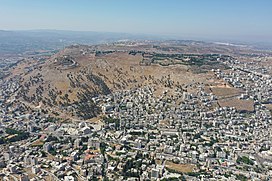
Back جبل جرزيم Arabic جبل جرزيم ARZ Герызім Byelorussian Гаризим Bulgarian Menez Garizim Breton Mont Garizim Catalan Jabal aţ Ţūr (bukid sa Kayutaang Palestinhon) CEB Gerizim Czech Garizim German Γαριζίν Greek
| Gerizim | |
|---|---|
 Mount Gerizim seen from above | |
| Highest point | |
| Coordinates | 32°12′3.1″N 35°16′23.73″E / 32.200861°N 35.2732583°E |
| Geography | |
| Parent range | Samarian mountains |

Mount Gerizim (/ˈɡɛrɪˌzɪm/; Samaritan Hebrew: ࠄࠟࠓࠬࠂࠟࠓࠩࠆࠝࠉࠌ ʾĀ̊rgā̊rīzem; Hebrew: הַר גְּרִזִים Har Gərīzīm; Arabic: جَبَل جَرِزِيم Jabal Jarizīm or جَبَلُ ٱلطُّورِ Jabal at-Ṭūr) is one of two mountains in the immediate vicinity of the Palestinian city of Nablus and the biblical city of Shechem.[1] It forms the southern side of the valley in which Nablus is situated, the northern side being formed by Mount Ebal.[2] The mountain is one of the highest peaks in the West Bank and rises to 881 m (2,890 ft) above sea level, 70 m (230 ft) lower than Mount Ebal.[3] The mountain is particularly steep on the northern side, is sparsely covered at the top with shrubbery, and lower down there is a spring with a high yield of fresh water.[4] For the Samaritan people, most of whom live around it, Mount Gerizim is considered the holiest place on Earth.[5]
The mountain is mentioned in the Bible as the place where, upon first entering the Promised Land after the Exodus, the Israelites performed ceremonies of blessings, as they had been instructed by Moses.[6]
Mount Gerizim is sacred to the Samaritans, who regard it, rather than Jerusalem's Temple Mount, as the location chosen by God for a holy temple. In Samaritan tradition, it is the oldest and most central mountain in the world, towering above the Great Flood and providing the first land for Noah’s disembarkation.[7] It is also the location where Abraham almost sacrificed his son Isaac.[5] Jews, on the other hand, consider the location of the near-sacrifice to be Mount Moriah, traditionally identified by them with the Temple Mount. Mount Gerizim continues to be the centre of Samaritan religion to this day, and Samaritans ascend it three times a year: at Passover, Shavuot and Sukkot.[1] Passover is still celebrated by the Samaritans with a lamb sacrifice on Mount Gerizim.[8] Today, about half of the remaining Samaritans live in close proximity to Gerizim, mostly in the small village of Kiryat Luza.
The Samaritan village of Kiryat Luza and an Israeli settlement, Har Brakha, are situated on the ridge of Mount Gerizim.[9][10]
- ^ a b "3. The Votive Inscriptions from Mount Gerizim". Before the God in this Place for Good Remembrance. De Gruyter. 2013-05-28. pp. 52–90. doi:10.1515/9783110301878.52. ISBN 978-3-11-030187-8.
- ^ "Mount Gerizim". Encyclopedia Britannica. Retrieved December 24, 2020.
- ^ Matthew Sturgis, It aint necessarily so, ISBN 0-7472-4510-X
- ^ Jewish Encyclopedia
- ^ a b UNESCO World Heritage Centre (2 April 2012). "Mount Gerizim and the Samaritans (Submission for admission as UNESCO World Heritage site presented by the State of Palestine)". Retrieved 24 December 2020.
- ^ Deuteronomy 11:29–30
- ^ Anderson, Robert T., "Mount Gerizim: Navel of the World", Biblical Archaeologist Vol. 43, No. 4 (Autumn 1980), pp 217-218
- ^ "Photograph of this". Archived from the original on 2016-05-12. Retrieved 2014-05-01.
- ^ "Har Bracha - The Community". Yeshivat Har Bracha. Retrieved 2022-01-13.
- ^ "Not Muslim, Not Jewish: Ancient Community in the West Bank Feels Increasingly Israeli". Haaretz. Retrieved 2022-01-13.
© MMXXIII Rich X Search. We shall prevail. All rights reserved. Rich X Search

